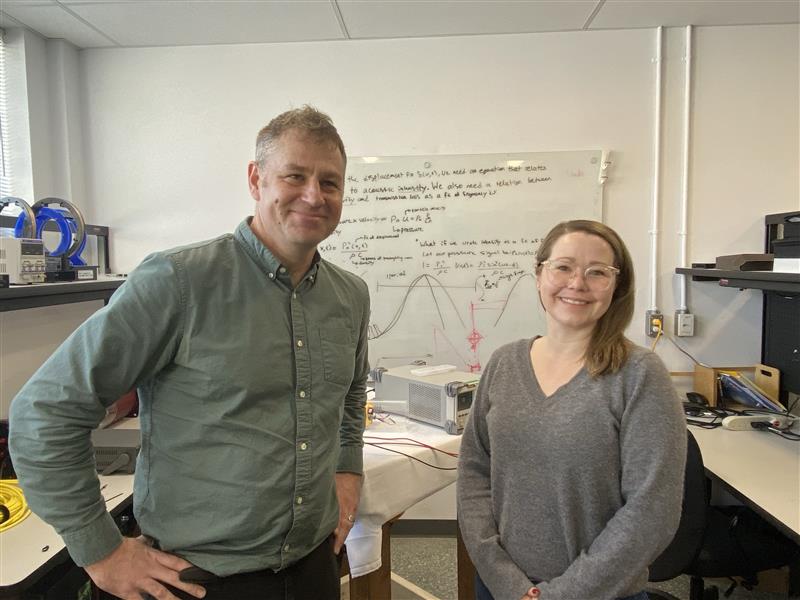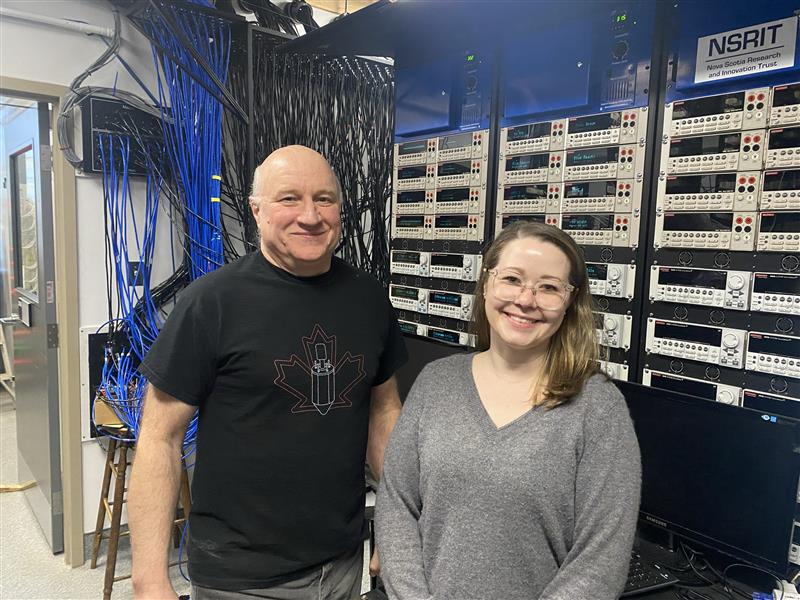A small team from Perimeter, led by Director of External Relations Emily Petroff, recently toured Dalhousie University and spoke with three groups pursuing fascinating, world-changing research.
At each stop, the team got to see firsthand the great work being done in different areas of study, all of which rely on physics in some way to push their research further. We would like to thank Drs. Bousquet, Dosag, Dahn, and their teams for their hospitality and for showing us their incredible research.
Stop 1: The quantum future of underwater communication
At MINDI Hub, the Perimeter team met with director Jean‑François Bousquet about his work in underwater communication technology.
“Sensing and communications in the arctic will be very important for biology and for defence,” Bousquet explained. He described many uses for new forms of technology, including biologists tracking fish migration and helping crewed and uncrewed devices communicate in the Arctic.
Currently, underwater communication relies on magnetic fields to help increase the distance. But currently, a viable network of devices that can talk to each other both in the water, across the air-water divide, and over and under ice, has too short a range. To help with these issues, Bousquet and his team have turned to quantum technology to help.
Bousquet and his team are using Quantized Superconducting Quantum Interference Device (SQUID) chips to increase range and precision. By using a quantized device, researchers can use fewer devices, leading to more efficiency. Eventually, the detector range could be powerful enough that you could fly a drone over the ice to communicate with things under the device. What was once an expensive and impractical solution is now a real hope for a robust sensor and communication network in the Arctic.
Stop 2: Renewable solutions to hydrogen production and water filtration
The Perimeter team then met with the Dasog Research Group, where Dr. Mita Dasog and her team study and experiment with electrocatalysts: materials that make up electrodes or coat electrodes to help with electrochemical reactions.
“We are a material synthesis group so we try to understand how are reactions proceeding,” Dasog explained. “How does that affect the material properties? How can we tune them? How can we make them more green, more sustainable, and scalable?”
Dasog and her team walked us through two of their projects: water desalination and green hydrogen production. The group’s desalination device made headlines last year and uses plasmonics to evaporate water using only sunlight, which is an effective way to desalinate water.
But they haven’t stopped at desalination. “We can remove heavy metals. We can remove organic impurities, but we can also remove microbes, because it heats up and that also kills microbes,” Dasog said.
Dasog and her team also discussed finding less expensive materials for electrolysis, which currently relies on platinum and iridium for hydrogen production. Group member Sana Kashgouli talked us through her AI tool that combs through current research extracts relevant data about potential alternatives to platinum and iridium. The team can then use that data to help identify different catalysts. Two other group members, Dr. Blaine Fiss and Dr. Sarah Martell, then took us to their lab where they showed us how they are trying to produce materials that could be viable contenders to replace more expensive materials.
Stop 3: Pushing the limits of lithium-ion batteries
Perimeter’s final stop was to meet with Jeff Dahn, the NSERC/Tesla Canada Industrial Research Chair at Dalhousie University. In his lab, Dahn and his team of researchers are testing lithium-ion batteries to increase their energy density, decrease their cost, and improve their lifecycle and lifespan. Their work is already being applied to electric vehicles and implantable medical devices, where battery lifespan is extremely important.
Dahn walked the Perimeter team through how current lithium-ion batteries work before showing us two labs testing battery effectiveness and lifespans. In the first lab, teams are testing electrolytes by accelerating bad reactions and measuring gas the batteries give off.
“It’s incredibly valuable because it can rapidly tell us which electro materials are best, which electrolytes are best, and so on,” explained Dahn. “We're always trying to push the voltage higher and higher because there's more capacity and energy that you can get.”
In the second space, Dahn’s group is charging and discharging batteries to find issues where they lose capacity or fail entirely, pushing batteries to their limit in a matter of [months] where it might take years out in the resl world. Dahn explained that modelling has been done using physics first principles and they’re now empirically measuring batteries to understand how batteries can be more efficient in charging and retaining their energy levels.
The Perimeter Team would again like to thank everyone at Dalhousie University for their hospitality and for sharing their incredible work with us. We look forward to when our paths cross again.
About PI
Perimeter Institute is the world’s largest research hub devoted to theoretical physics. The independent Institute was founded in 1999 to foster breakthroughs in the fundamental understanding of our universe, from the smallest particles to the entire cosmos. Research at Perimeter is motivated by the understanding that fundamental science advances human knowledge and catalyzes innovation, and that today’s theoretical physics is tomorrow’s technology. Located in the Region of Waterloo, the not-for-profit Institute is a unique public-private endeavour, including the Governments of Ontario and Canada, that enables cutting-edge research, trains the next generation of scientific pioneers, and shares the power of physics through award-winning educational outreach and public engagement.
You might be interested in



Battle of the Big Bang: New Theories Changing How We Understand the Universe
June 5, 2025



